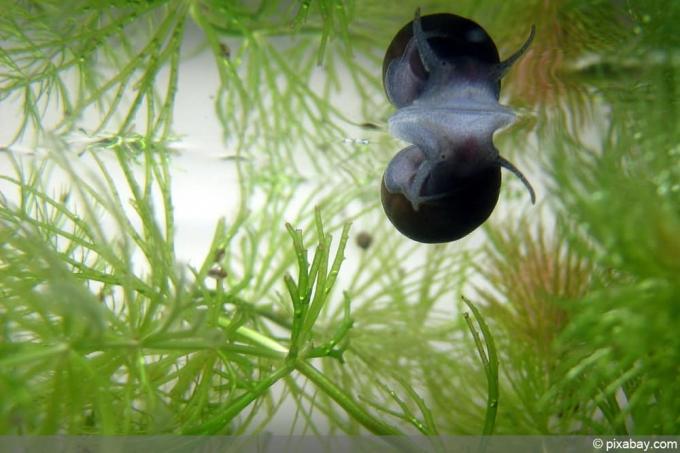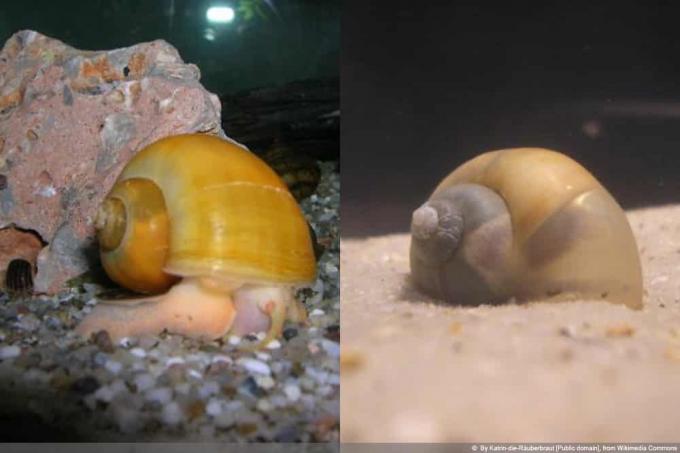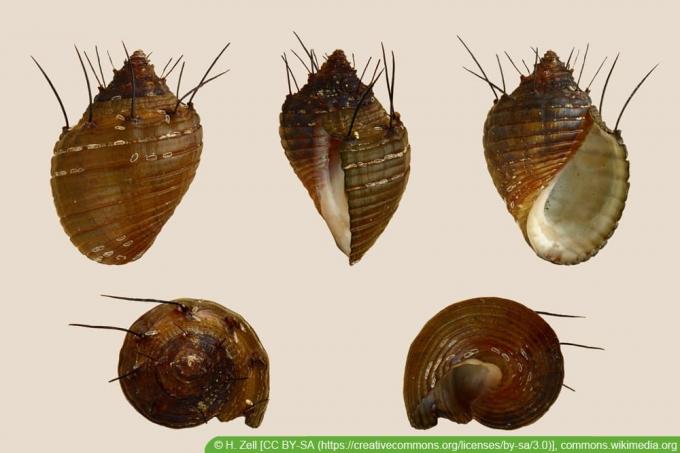

Table of contents
- Origin
- species
- distribution ban
- aquarium keeping
- water temperature
- Neighbors
- food
- mineral requirement
- breathing
- propagation
- breed
- reproduction control
- usefulness
- Diseases
There are actually snails that are welcome. Snails, who can help themselves to our plants to their heart's content. We're talking about apple snails, the cute water creatures from the far-off tropics. In addition to their appetite for plant remains and algae, they delight their owners with their pretty, colorful little houses. Keeping them in the aquarium is very easy. However, a few wishes must be fulfilled.
Origin
The Ampullariidae, as the apple snails are scientifically called, were designed by evolution to live in the tropics. Everywhere on earth where tropical conditions prevail, the different genera can be found. Their original distribution areas are in South America, Central America, Africa and Asia. In the meantime, they have also been abducted to other areas, where they have found a new home under favorable conditions. Since they usually have no natural enemies there, they have developed into a plague for the native flora and fauna. Apple snails can also be found worldwide as aquarium inhabitants. The name apple snail can be traced back to the shell of the snail, which is reminiscent of an apple in shape.
species
Many different species of apple snails are known worldwide. Some of these species are particularly in demand for keeping in the aquarium.
paradise snail:
- Scientifically: Marisa cornuarietis
- case diameter approx. 5 cm
- Housing color is cream to light brown
- with dark brown stripes
- there are also golden yellow without stripes
- reminiscent of a giant ramshorn snail,
- but is still an apple snail
- is one of the most voracious specimens
- destroys living plants
- multiplies extremely well
Zebra Apple Snail:
- scientifically: Asolene spixi
- case diameter up to approx. 4 cm
- the shell is light brown with darker stripes
- more reluctant to eat
- mostly spares the plants
- more nocturnal
- likes to bury himself
Giant apple snail:
- scientifically Pila ampullacea
- Housing height up to approx. 10 centimeters
- the housing is reddish brown to dark brown
- occasionally with darker spiral stripes
- also eats plants
- loves to dig
Pomacea species:
- the most popular species is Pomacea diffusa
- does not eat living plants
- Housing height up to approx. 5.5 cm
- Case colors: white, yellow, brown, pink, purple, blue
- other Pomacea species grow larger
- are less colorful
- also eat plants
- all Pomacea species are subject to a distribution ban
distribution ban

Spanish farmers have been suffering from the apple snail Pomacea insularum for years. This species was introduced into the Ebro Delta where it encountered no natural predators. The result was massive proliferation. They cavort there in the free nature, especially in the water-rich rice basins. Year after year, the voracious little animals cause great damage in agriculture. For this reason, in 2012 some legal regulations were passed on their maintenance and distribution, which apply to the entire EU area.
- the Pomacea species are difficult to distinguish
- therefore all species are affected
- also the popular Pomacea diffusa
- The regulation also applies to hobbyists
- Pomaceas may be kept
- Breeding for personal use is allowed
- FORBIDDEN: the passing on/marketing of the snails
A notice:
Unlike in Spain, there is no danger in our latitudes that these apple snails will spread in the wild. The winters are much too cold for that. The snails would not survive the sub-zero temperatures.
aquarium keeping
The apple snails usually inhabit swampy areas in their homeland. In this country you will not find such living conditions in the wild. In addition, they do not tolerate the winter cold, which is why they are kept almost exclusively in aquariums. In order for the apple snails to fill up in it, their water world should meet a few requirements. Under good conditions they can reach an age of 4 years.
- Aquarium should be at least 10 liters in size
- no more than one snail per 10 liters of water
- Pelvis should be covered
- Water with a high degree of hardness
- A pH of 7 to 8.5 is optimal
- Aquarium gravel and oxygen stones are sufficient as a basis
Tip:
Dappled apples can also live in ponds in summer. Here, however, flying enemies lurk, like blackbirds. They skilfully fish the snails out of the water. In winter, snails need to hibernate in an aquarium.
water temperature
Apple snails need the wet element to live. In order for them to be able to develop optimally in it, it must be at a good temperature throughout.
- Apple snails don't like cold water at all
- in winter they would freeze to death in the pond
- the ideal water temperature is between 18 and 28 degrees
- the higher the heat, the more active the snails are
Neighbors
An aquarium with only apple snails can be a bit boring in the long run. However, this does not have to be the case. These snails don't need to be solitary as they get along well with a number of other aquatic animals and plants.
- all ornamental fish are good neighbors
- but no snail-eating fish
- Plants are allowed to grow in their habitat
Tip:
If some fish keep trying to nibble at the snail's siphon, they could damage it. Since the snails need the siphon for air breathing, they have to be separated from these fish.
food

Apple snails feed mainly on plant food. However, they are not strictly herbivores. They also welcome live food, which they cleverly catch on the water surface. The more food the snails have available, the more they multiply. Anyone who keeps crabs in the aquarium can take advantage of this. Apple snails are ideal protein food for the pincers.
- feed mostly on plant foods
- Pomacea diffusa prefers soft algae and dead plant material
- Pomacea diffusa must be fed
- other species do not stop at living plants either
- the result is pitting
- or even the complete destruction of the aquarium plants
- vegetables can also be fed
- Insect larvae, carrion and biofilm are also snail food
- Snail eggs from other snails are popular sources of protein
Tip:
Apple snails like to eat lettuce leaves and cucumber slices. However, they should first be scalded with hot water. The vegetables should never remain in the water for more than two days, otherwise they will start to rot.
mineral requirement
Apple snails need plenty of calcium to build and maintain their beautiful little houses. This must be available to them at all times. Here are some good sources of calcium:
- crushed eggshells
- calcareous mineral feed
- cuttlebones
- special snail food
However, snails do not only absorb calcium from food, they also extract it from the aquarium water. This gradually changes the water quality.
- the water becomes soft and acidic
- acidic water will attack the housing
- Regular water changes are therefore mandatory
- change smaller amounts of water with young snails, but more often
breathing
Apple snails need enough air to live. But don't worry, the snails living in the water are also well supplied with it. Since water is often low in oxygen, the snails have come up with something to ensure that their oxygen supply is always secured.
- they have a special anatomical solution
- they have both gills and lungs
- additionally also a siphon
Tip:
The sipho is a kind of tube, similar to a snorkel. This allows the snails to suck in fresh air without having to come out of the water.
propagation
Aquatic snails are often hermaphrodites, but this is not the case for apple snails. They develop as separate sexes.
- Mating is required
- Reproduction via eggs
- 200 to 250 eggs are laid
- Egg color varies depending on the snail species
- Eggs are laid on the water surface
- often on the inside of the cover
- on stems of plants
- some species lay their eggs in water
A notice:
Snails can create a seed depot. They are then able to lay eggs for another 9 months without contact with other snails.
breed
Apple snails are available cheaply in stores, but you can also easily breed them yourself. For this you need at least two animals: a male and a female. The animals of this snail species are already sexually mature at 7 months. With some apple snails, the two sexes cannot be distinguished externally. However, this can be determined by observation.
- when mating, the male animal is at the top
- if there are two crawling snails, the last snail is usually the male

Katrin-the-Robber-Bride, Sircedric, edited by Hausgarten, CC0 1.0.
As soon as a pair has been found among the snails kept, mating begins. The course of nature eventually produces many new snails by itself after a while. For you as the owner, it is sufficient if you support the process with optimal conditions:
- warm water favors the multiplication
- Pomacea species lay eggs outside of the water
- There should be some space between the water surface and the lid
- high humidity is important
- laid eggs must not dry out
- in warm places, additionally moisten eggs
- rub it over it daily with a moistened finger
- other species also lay eggs in water
- after about 2 to 6 weeks the young snails hatch
- they fall into the water by themselves
- if not, then help with the hand
- feed with dust food in the first two weeks
- Secure filter inputs with nylon stocking
- possibly. Keep fish away as some will eat the young
Tip:
Eggs laid on the aquarium lid can sometimes fall off again. However, they stick well with a little icing. However, no citric acid may be added to this.
reproduction control
After mating, the apple snail lays more than 200 eggs. Under favorable conditions, a very high percentage of them can hatch. But sometimes you already have enough snails and don't want any more offspring. The most effective reproduction control is to simply collect the spawn by hand and remove it from the tank. Then there is no need to find a solution for many young snails. Especially the animals of the popular Pomacea diffusa must not be passed on. For your own breeding, uncontrolled propagation quickly reaches its limits. After all, every young snail eventually becomes an adult snail and requires sufficient space in the "spatially limited" aquarium.
usefulness
Apple snails adorn every local water world and that is usually the purpose of keeping them. In addition, they are also useful animals in aquaristics. They eat away plant remains and algae and can therefore be used as a natural "cleaning power". Only with the very voracious varieties is there an appropriate number, so that they cannot eat away the entire plant world in no time.
Diseases
Apple snails are amazingly tough creatures, but they can still be afflicted by diseases. The cause of many symptoms of the disease is not exactly known. Also, there are no effective remedies against it. Here it helps to prevent and to offer the snails optimal living conditions so that their immune system develops well.
- avoid further infection
- remove diseased snails from the aquarium
- possibly. keep separate
- sometimes the snails recover
- check the water hardness if the housing is damaged
- changing water hardness should be avoided
Snails do not tolerate changes in the water quality very well. If they have to be implemented, the adaptation to the new area of life should be done carefully. To do this, they are first placed in a bag with aquarium water and then placed in the new aquarium together with them. They are only released after a temperature adjustment.
 garden editorial
garden editorial I write about everything that interests me in my garden.
Learn more about pond animals

Marsh snail in the pond | 9 Posture Tips
Of the nearly 100,000 species of snails, only about 40 live in freshwater. The mud snail is one of the ten species that can also be found in a pond. It inhabits the bottom of the body of water and contributes significantly to cleaning it there.

Swimming pond with fish: This is how the combination works
A swimming pond with fish can be a very special highlight in the garden. However, the fish pose special challenges because the nutrient content of the water is significantly increased. However, the combination is possible with an appropriate structure and comprehensive filtering.

Tower snails | 13 tips for keeping & propagation
Tower snails are particularly popular aquatic animals in garden ponds - at least as long as they don't multiply endlessly. They also signal in aquaria whether optimal conditions exist. Tips for husbandry and propagation create an improved habitat without mass propagation.

Keeping pond mussels in the garden pond | 9 Posture Tips
The trend towards natural garden ponds has been unbroken for years. Many garden owners use it to create their own small wet biotope. However, this is not possible without appropriate stocking with plants, small fish and pond mussels.

Dragonfly larvae in the pond: what do dragonflies eat?
Anyone who finds dragonfly larvae in the pond can be happy. Because the insects are useful predators and can, for example, reduce the number of mosquitoes. However, they do not feed exclusively on animals that can cause harm. Here's what dragonflies eat.

Keeping Sunfish in the Pond | 7 tips on husbandry & feed
Perch are predatory fish and therefore rather unsuitable for pond keeping. An exception, however, is the magnificent bluegill, which usually gets along well with other fish. Here is what you need to pay attention to when keeping it.

